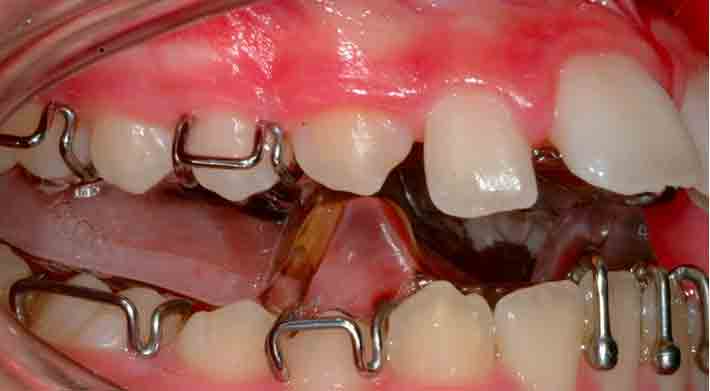Review Intervals with the Twin Block: Too much of a good thing?
How often should we see our patients during Twin Block therapy? Arbitrarily, I have historically seen these patients after one month and as little as 3-monthly after that. This approach seemed to balance ensuring that patients got off to a good start without overburdening them with in-office visits later in treatment.
More recently (perhaps having seen more and often surprising failures), I have gravitated towards seeing patients more regularly. Again, however, the direction of travel in the specialty appears to be that ‘less is more. This is because all basic remote monitoring systems forms are heralded as transformational and increasingly ushered in as a brave new normal.
There has been some research evaluating the effectiveness of these remote monitoring systems. I’m sure more will emerge. However, there is also a lack of research to answer fundamental questions. For example, how often should we see our patients with conventional removable appliances, functional appliances, aligners, or fixed appliances?
A Swedish-based team did this study to partially address this issue by evaluating the impact of varying appointment intervals during Twin Block therapy. The European Journal of Orthodontics published this study.

Erik Frilund, Mikael Sonesson and Anders Magnusson
EJO. DOI: 10.1093/ejo/cjac046
What did they do?
They conducted a randomised controlled trial involving two groups and 88 participants.
Participants:
Children are aged 8–14 years with an overjet of 6 mm or more and incompetent lips. They were treated with the Twin Block appliance
Interventions:
They randomly allocated the participants into one of two groups with 6-weekly (Group 1) or 4-weekly (Group 2) recall intervals. They concealed the allocation well. Finally, they evaluated the data on an intention-to-treat basis. Blinding was only possible for the study model measurements.
The operators provided Twin Block therapy over 12 months using a fairly standard design. Importantly, they recommended 12 hours of daily wear. I could not find information on whether they wanted the participants to wear their appliances during specific periods (night or day). They used a Theramon timer in the acrylic base in the appliance’s lower component to measure the appliance’s wear time.
Outcomes:
The team recorded the wear-time, overjet, overbite, and molar relationships every 12th week and after 1 year (T1). Notably, they defined success as a final overjet of 4mm or less with Class I molar relationships. T
What did they find?
The authors reported a range of findings. Many of these were unrelated to the research question. Nevertheless, I thought most of the results were interesting. In terms of the main research question, they did not find any benefit from the 4-weekly recall. Interestingly, the duration of wear was 6.9 hours/day and 6.1 hours/day in the 6-weekly and 4-weekly recall groups, respectively. These differences were not statistically significant. The mean overjet at T1 was 3mm with 6-weekly recall and 3.8mm with 4-weekly recall.
Other interesting findings included the following:
- The mean wear-time for successfully treated patients was 6.8 hours daily compared to 5.2 hours daily in those that were not successful
- The success rate of therapy was estimated at 59%.
- The overjet was reduced to 4mm in 54 of 73 patients completing treatment, while complete molar correction was observed in 45 of 73 patients.
- Success did not seem to be influenced by either gender, age, or initial overjet.
- After the initial period of adaptation, wear time seemed to reduce over the 12 months (although wear levels were pretty constant between 6 and 9 months in the 6-weekly recall group)
What did I think?
I really liked this study. We are often quite reticent to evaluate our failures. However, failure to successfully treat large overjets in early adolescence is problematic. Particularly as we know that this type of malocclusion can be an important and frequent source of teasing and bullying in young children. The main explanation for failure with the Twin Block is poor compliance. It is, therefore, heartening to see a study considering means to overcome this problem.
From a methodological perspective, the study was excellent. The authors have undertaken numerous similar projects and ensured that the risk of bias was minimal. They also clearly reported the findings and were candid about some of the study’s limitations.
I felt that the difference between the interventions (4- vs 6-week review) was perhaps a little too conservative. I wonder whether other tailored protocols, for example, involving very regular review at the outset, could have been considered. Equally, a control group with less frequent recall (perhaps primarily 3-monthly) may have helped to isolate between-group differences. Similarly, it would be nice to consider allied projects involving in-person and remote reviews to more traditional approaches.
Finally, it was again revealing to see just how little patients seem to wear their appliances. Furthermore, these findings mirror our research evaluating the effectiveness of part-time and full-time wear protocols. Crucially, however, this study again highlights that part-time wear of removable appliances (of as little as 6 hours daily) seems sufficient to address significant inter-arch issues.
What can we conclude?
There was no meaningful difference in compliance with 4- vs 6- weekly review of a Twin Block. The authors are to be commended for making an excellent start on this topic; however, this does not mean my patients will see less of me. I continue to feel that ‘less is not necessarily more and await further and more nuanced research on this topic.

Professor of Orthodontics, Trinity College Dublin, The University of Dublin, Ireland
having used Twin Block appliances for over twenty years, I believe full-time wear with the exceptions of eating, oral hygiene, and contact sports would have yielded better results and faster.
An excellent study. Makes me feel better about asking my patients to wear their twin blocks from after their evening meal then overnight, leaving the appliance at home whilst at school for practical reasons!.
The study findings are similar to Dr. Proffitt’s assertion that no tooth movement occurs under 4-6 hours of pressure. 6 hours is the proposed threshold. I am not surprised because Twin Blocks do move teeth.
I aware of a practitioner who cements their twinblock appliances in with GIC. Perhaps this would make an interesting control study as full-time 24hr wear – I wonder if they could be persuaded. This must need very careful supervision for more than overjet reduction, with the entire dentition at risk of caries. Would this result in a 100% success rate?
My protocol is full time wear, including while eating. I believe this produces a better and faster outcome with the late researcher, Harry Orton’s Sagittal Treatment Complete (STC) regularly achieved after three to four months. After issuing the appliance I try to get the patient back in three days. That’s because I want to see how they are managing and especially if they are eating with the appliance in. If I left it a month before seeing them, a percentage of them would have firmly decided by then that you can’t eat or even talk with the twin blocks in. I want to nip that in the bud. If they are managing, I see them again in two weeks, but if not, even sooner, so that I can again encourage and repeat the request for full time wear. After that I start making appointments six weekly. I believe the initial hand holding is crucial to achieving a high success rate.
Great study ,
Full time wear except eating and beush should be encouraged as most of them then wear only 6-10 hours..
I wonder why some practitioner do not add labial bow . I have seen upper incisors flaring without labial bow.
Adding a bow keep slightly passive is the best strategy…
The grandparent to invis with MA! I’ve also been using it for 2 decades and I do FT wear with 2-3 month recall intervals. Works like a charm and a fraction of the Invis First lab fee!